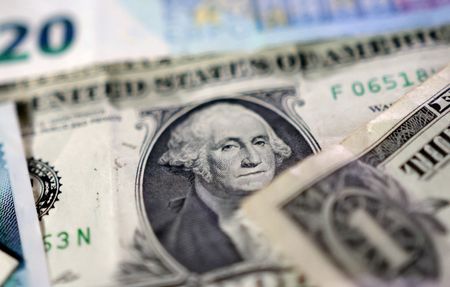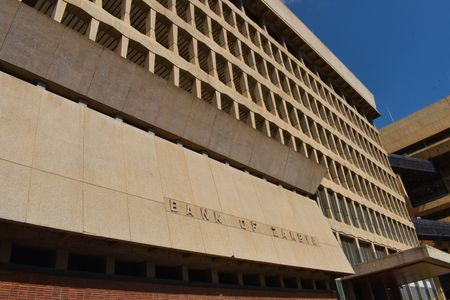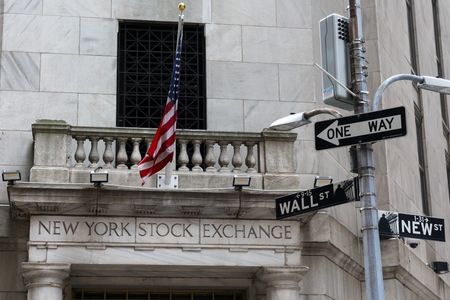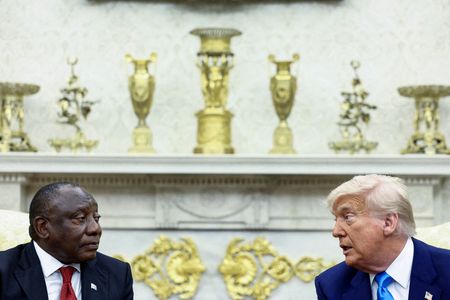By Ankur Banerjee and Amanda Cooper
SINGAPORE/LONDON (Reuters) – The dollar headed for its first weekly drop against a range of currencies in five weeks on Friday, as worries over the United States’ worsening fiscal health sent investors into other markets.
After Moody’s last week downgraded its U.S. debt ratings, investor attention this week has honed in on the country’s $36 trillion debt pile and U.S. President Donald Trump’s tax bill, which could add trillions of dollars more to it.
Dubbed by Trump as a “big, beautiful bill”, it narrowly passed the Republican-controlled U.S. House of Representatives and now heads to the Senate for what is likely to be weeks of debate, keeping investor sentiment fragile in the near term.
The euro rose 0.5% to $1.1338 on Friday and is set for a 1% gain for the week after four straight weeks of losses as a pause in tariffs gave the dollar a brief lift in recent weeks.
The euro, though, is up 9% in 2025, and has emerged as the early winner of the tariff-induced market tumult and investors fleeing the dollar, looking for safer bets.
The currency shrugged off a report from the Financial Times on how Trump’s trade negotiators are pushing the European Union to make unilateral tariff reductions on U.S. goods.
Without concessions, the FT reported, the EU will not progress in talks to avoid additional 20% “reciprocal” duties. Reuters was unable to immediately verify the report.
The dollar index, which measures the performance of the U.S. currency against six others, is set for a 1.35% decline this week and was down 0.3% at 99.614.
U.S. DEBT CONCERNS
Antje Praefcke, a currency strategist at Commerzbank, said that while the risk of a U.S. recession has diminished, government finances will become more of a catalyst for the dollar.
“Perhaps the issue will now become more pressing as it is being discussed more in public. I am curious to see when the market will realise that this is the next major (structural) burden on the dollar,” she said.
Treasury yields have risen this week in response to the likely increase in the U.S. debt pile. The 30-year bond yield traded above 5% on Friday, near 19-month highs. It is close to October 2023’s high of 5.179%, a break past which would take it to its highest since mid-2007.
The elevated yield hasn’t underpinned the dollar as investors flee U.S. assets in a “Sell America” move similar to last month.
“What has become quite stark this week is the reaction function in broad markets to the rise in U.S. long-end Treasury yields,” said Chris Weston, head of research at Pepperstone.
Weston said higher yields were not being driven by improved growth dynamics, but by concerns of increasing fiscal recklessness, deficit spending and the perception of higher interest expenses.
“Add in the toxic mix of higher inflation expectations … and the net effect has been a strong rise in ‘term premium’ and the would-be foreign buyers simply staying out of the market.”
The yen strengthened to 143.47 per dollar, on course for a 1.5% rise for the week, after Japan’s core inflation accelerated at its fastest annual pace in more than two years in April, raising the odds of another interest rate hike by year-end.
The data underscores the quandary facing the Bank of Japan, which must grapple with price pressures from persistent food inflation as well as economic headwinds from Trump’s tariffs.
Super-long Japanese government bonds have also scaled record highs this week, although they were steady on Friday. [JP/]
The Swiss franc was slightly stronger at 0.8265 per dollar, also set for a 1.2% rise for the week after two weeks of losses.
(Reporting by Ankur Banerjee in Singapore; Editing by Edwina Gibbs, Stephen Coates and Gareth Jones)








